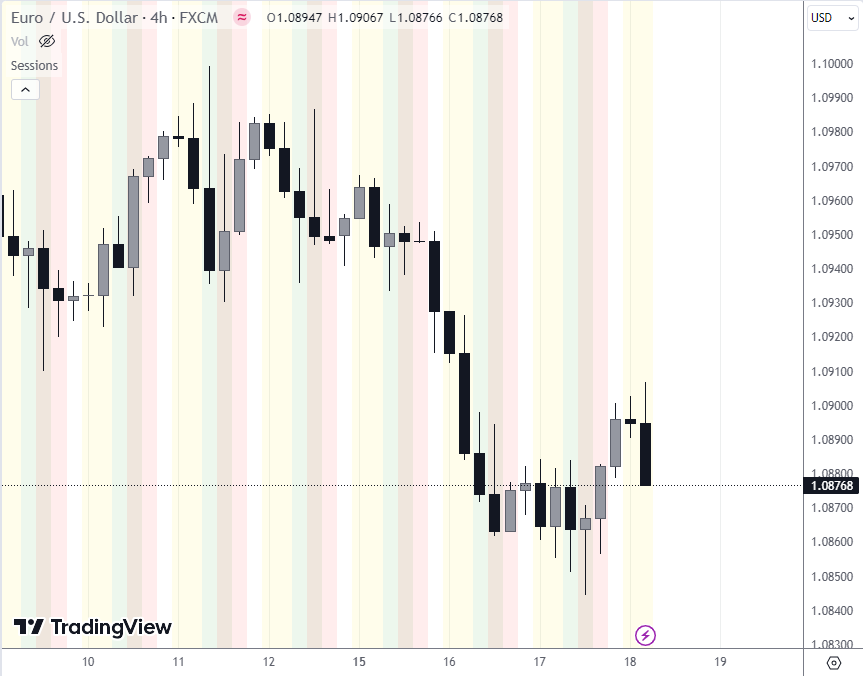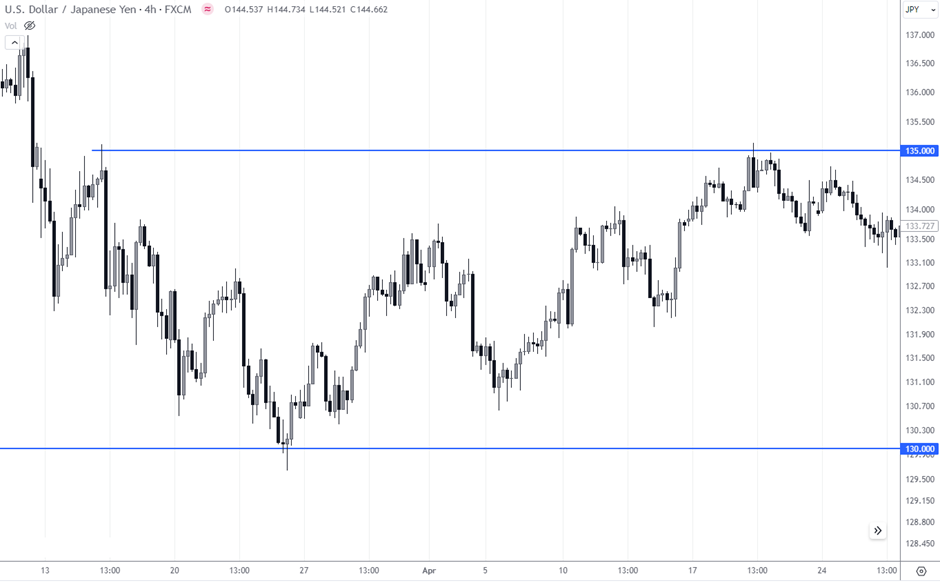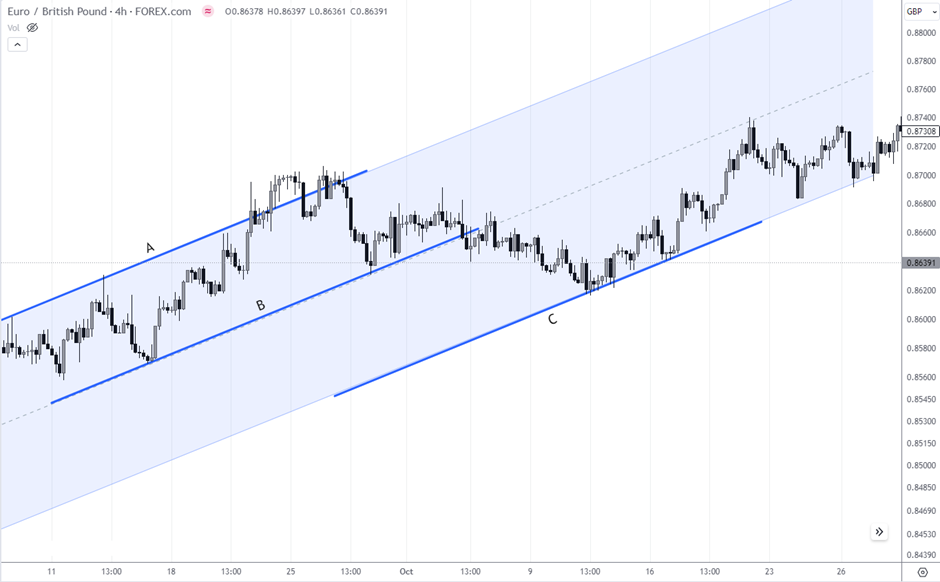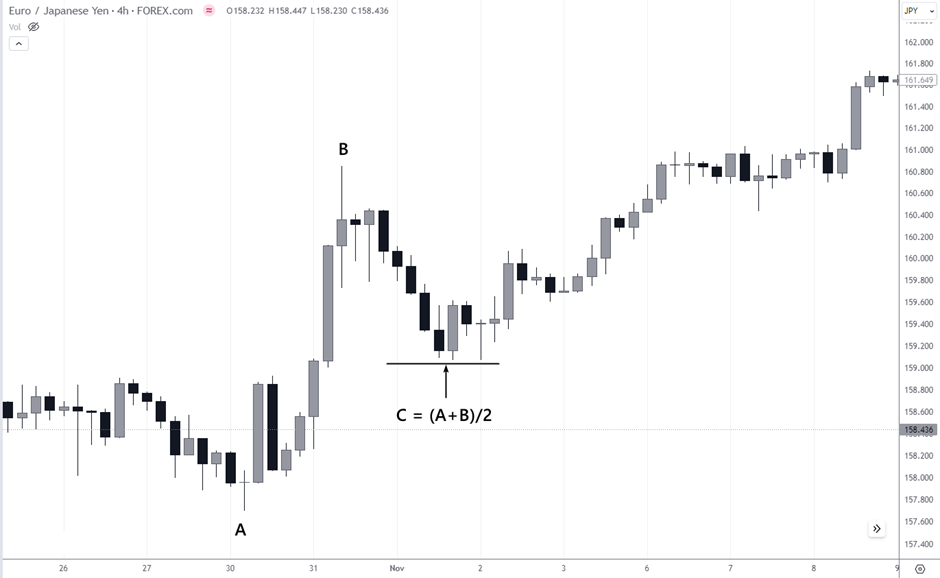4 Swing Trading Strategies to Trade on the 4 Hour Timeframe



Editorial Note: While we adhere to strict Editorial Integrity, this post may contain references to products from our partners. Here's an explanation for How We Make Money. None of the data and information on this webpage constitutes investment advice according to our Disclaimer.
Pros of 4-hour trading:
- Smoothes out the noise of lower timeframes
- Requires only a few daily check-ins for managing swing positions
- Trades held from days to weeks allow for bigger profit targets
- Less emotional stress
Cons of 4-hour trading:
- Lower frequency of trading opportunities
- Requires wider stops due to the larger timeframe, leading to a potentially bigger loss per trade
- Trades held from days to weeks allow for bigger profit targets
Trading the financial markets involves decisions on which timeframes to analyze and execute trades. While day traders concentrate on minutes and hourly charts, swing traders favor larger timeframes like 4 hours or daily. This article specifically explores the pros and cons of trading in the 4-hour timeframe.
The 4-hour timeframe, as the name suggests, organizes price data into 4-hour blocks. Strategies designed for the 4-hour charts aim to capture moves lasting from a few days to several weeks, making it ideal for swing trading.
Forex 4 hour time frame
The 4-hour time frame in Forex trading stands out with unique features that distinguish it from other time frames:
Six 4-hour Candles in a Day:
Each day in the 4-hour time frame is represented by the formation of six individual 4-hour candles
These candles capture price movements and fluctuations within four hours throughout the day
Divining a day into six candles gives traders a more granular view of price changes, allowing for a detailed analysis of market dynamics
4 Hours as Half a Working Day:
The 4-hour time frame is significant as it encapsulates half of a typical working day
For traders who follow this time frame, it offers a balanced and manageable approach to monitoring market conditions
This division aligns with breaking down the trading day into smaller, more digestible segments, making it well-suited for those with other professional or personal commitments
The 4-hour time frame provides traders with a comprehensive snapshot of market movements throughout the day. Please refer to this article, What Is The Best Time Frame To Trade Forex For Beginners? to know more about the time frame.
4 hour candle close times
The structure of a 4-hour candlestick incorporates data from various trading sessions, providing insights into market activity during distinct time intervals.
UTC Close Times:
02:00
06:00
10:00
14:00
18:00
22:00
The 4-hour candlestick is unique in that it encapsulates data from multiple trading sessions, reflecting the dynamic nature of the forex market. The breakdown typically follows the progression of major global trading sessions: Asia, Europe, North America, and back to Asia.
 4-hour timeframe specifically covers different trading sessions: Asia, Europe, America
4-hour timeframe specifically covers different trading sessions: Asia, Europe, AmericaThus, 6 candles are formed on the 4-hour chart per day:
Candle 1: Asian markets are starting to open, including Japan and Australia. This period is often characterized by low volatility due to the closure of major markets. Trading may be less active at this time, but important news or economic events from the previous trading day may influence price movements
Candle 2: The major Asian markets are in full swing. Activity begins to increase as markets open in countries such as China and Singapore. This time often brings the first significant price movements of the day, especially if economic data has been released in Asia
Candle 3: European markets are open and Asian markets are starting to close. Volatility may increase during this period due to the overlap between Asian and European trading sessions. The opening of European markets brings new entrants and possible changes in trends
Candle 4: European markets are still open, US markets are starting to work. Period of high volatility due to joint activity of European and American markets. Important news and economic reports from Europe and the US may cause significant price fluctuations
Candle 5: The US market is at the peak of activity, European markets are closing. The US session continues to be active in the markets. US Federal Reserve decisions, corporate earnings reports and other key news from the US could have a significant impact on the markets
Candle 6: The U.S. market is beginning to slow down, preparing for the close of the day. A period of calm before the US session closes. Volatility may decrease, however, U.S. economic news released later in the day may cause price movement
Understanding the character profile for each 4-hour candle allows traders to contextualize price movements within specific timeframes and global trading sessions.
What are the best Forex brokers for swing trading?
When selecting the best Forex brokers for swing trading, it's essential to consider factors such as low overnight swap rates, access to advanced charting tools like TradingView, and the availability of a wide range of currency pairs. After comparing the conditions of three regulated brokers, we have identified the top options that offer favorable conditions for swing traders.
| Eightcap | Vantage Markets | IC Markets | |
|---|---|---|---|
|
TradingView advanced charting |
Yes | Yes | Yes |
|
EUR/USD spread |
0,1 | 0,3 | 0,1 |
|
Regulation |
ASIC, SCB, CySEC, FCA | ASIC, FCA, FSCA, VFSC | ASIC, CySEC, and FSA |
|
Supported urrency pairs |
40 | 40 | 61 |
|
Low swap rates |
Yes | Yes | Yes |
|
Open account |
Open an account Your capital is at risk. |
Open an account Your capital is at risk. |
Open an account Your capital is at risk. |
What are 4 hour Forex trading strategies?
The 4-hour chart is well-suited for implementing effective swing trading strategies. Below are four strategies tailored for this timeframe:
False Breakout of a Psychological Level
Using Fundamentals
Bounce from Parallel Channel Line
Correction to Fibonacci Level
False Breakout of a Psychological Level
Enter a position when a 4-hour candle punctures a round level but closes on the other side. This approach capitalizes on false breakouts, where initial price movements breach a psychological level but fail to sustain the momentum.
- Pros
- Cons
- Exploits market inefficiencies during false breakouts
- Maybe just for beginner traders
- Based on psychology
- It requires precise timing and analysis to distinguish false breakouts from genuine market shifts
 False Breakout of a Psychological Level
False Breakout of a Psychological LevelThe chart above shows 3 false breakouts: 2 for short entries, and 1 for long entries. The 4-hour chart can help to identify that the trend is weakening as we approach these levels to open a position after a false breakout.
A strategies based on fundamentals
Base trading decisions on fundamental factors, such as interest rate differentials between major currencies. For instance, if the Federal Reserve maintains high-interest rates while the Bank of Japan keeps rates low, it could drive the USD/JPY market.
- Pros
- Cons
- Serves as a foundation for identifying sustainable trends
- Aligns with long-term market drivers influenced by economic indicators and central bank policies
- It requires a strong understanding of fundamental analysis, which may be challenging for some traders
Bounce from Parallel Channel Line
Construct parallel channels (A-B) on the 4-hour chart and enter the direction of the main trend after a correction to the C line. This strategy identifies potential reversal points within an established trend.
- Pros
- Cons
- Utilizes technical analysis to identify entry points based on channel patterns
- Offers a systematic approach to capturing trend reversals
- Relies on accurate trendline construction and interpretation
 Bounce from Parallel Channel Line
Bounce from Parallel Channel LineThe picture above shows how on the 4 hour chart with the help of a parallel channel it was possible to find a long entry in the expectation of resumption of the uptrend.
Correction to Fibonacci Level
Use Fibonacci retracement levels on the 4-hour chart to identify potential reversal points after a correction. This strategy aims to capitalize on price movements that align with Fibonacci ratios.
- Pros
- Cons
- Integrates Fibonacci retracement, a widely used technical analysis tool
- Provides a systematic approach to identifying retracement levels for potential entries
- Requires a good understanding of Fibonacci retracement and its application
 Correction to Fibonacci Level
Correction to Fibonacci LevelThese four swing trading strategies tailored for the 4-hour timeframe offer a diverse set of approaches, combining technical and fundamental analysis to capture opportunities within the dynamic forex market. Traders can read this article - Best strategies to swing trade in Forex to choose strategies based on their risk tolerance, expertise, and market outlook.
Why trade the 4-hour Forex chart?
- Pros
- Cons
- Smoothes out the noise of lower timeframes, facilitating more precise identification of trends and ranges
- Requires only a few daily check-ins for managing swing positions, making it less time-intensive than shorter timeframes
- Trades held from days to weeks allow for bigger profit targets
- Characterized by a low psychological burden. Low risk of overtrading
- Lower frequency of trading opportunities compared to smaller timeframes
- Requires wider stops due to the larger timeframe, leading to a potentially bigger loss per trade
- It is easy to miss entry points if you monitor the opening of each 4-hour candle
You can read this article to know Most Relevant Forex Time Frames And Chart Settings for better timeframe insights.
Tips for trading on the 4-hour timeframe
Basic tip - combine the main 4-hour chart with other timeframes. By evaluating the market from different perspectives, you can better understand its state, stages and the strength of current trends.
Additional tips:
Set Stop-Loss Orders: Protect your capital by placing strategic stop-loss orders
Adjust Position Sizes: Tailor your investments to your risk tolerance for better control
Stick to Your Plan: Follow your trading strategy diligently to avoid impulsive decisions
Practice Patience: Wait for quality setups; don't chase every market move
Follow the News: Stay updated on relevant news for well-informed decisions
Conclusion
The 4-hour timeframe offers a well-rounded perspective for swing traders by minimizing short-term noise while capturing daily cycles. Ensure proper risk management due to the need for wider stops in this timeframe. Discipline is crucial – although no strategy assures profits, consistent practice can provide a competitive edge.
FAQs
What is the best timeframe to trade with?
The inquiry into the optimal trading timeframe is standard, with no universal "best" timeframe suitable for all traders. The ideal choice depends on trading style, risk tolerance, and time commitment.
Why do traders use different time frames?
Each timeframe offers a unique perspective on the market. Short-term views capture rapid price fluctuations, providing frequent but riskier trading opportunities. Medium-term analysis reveals underlying trends, aiding swing traders in identifying potential turning points. Long-term perspectives capture primary trend directions and market cycles, guiding position traders toward potential long-term investment opportunities.
Why trading higher time frames?
Trading on higher time frames is advantageous as it filters out market noise and false breakouts. Major trends become visible on daily, weekly, and monthly charts. Trading on higher time frames typically involves holding positions for longer-term swings, allowing for larger profit targets.
How does swing trading work?
Swing trading aims to capture intermediate moves lasting from a few days to several weeks. Swing traders identify trade setups on 4-hour, daily, or weekly charts and hold positions for the duration of the swing. Strategies may involve trend, range, or momentum trading based on key levels and indicators. Stop losses are placed wide to accommodate volatility.
Related Articles
Team that worked on the article
Upendra Goswami is a full-time digital content creator, marketer, and active investor. As a creator, he loves writing about online trading, blockchain, cryptocurrency, and stock trading.

Dr. BJ Johnson is a PhD in English Language and an editor with over 15 years of experience. He earned his degree in English Language in the U.S and the UK. In 2020, Dr. Johnson joined the Traders Union team. Since then, he has created over 100 exclusive articles and edited over 300 articles of other authors.
Tobi Opeyemi Amure is an editor and expert writer with over 7 years of experience. In 2023, Tobi joined the Traders Union team as an editor and fact checker, making sure to deliver trustworthy and reliable content. The topics he covers include trading signals, cryptocurrencies, Forex brokers, stock brokers, expert advisors, binary options.
Tobi Opeyemi Amure motto: The journey of a thousand miles begins with a single step.
Swing trading is a trading strategy that involves holding positions in financial assets, such as stocks or forex, for several days to weeks, aiming to profit from short- to medium-term price swings or "swings" in the market. Swing traders typically use technical and fundamental analysis to identify potential entry and exit points.
An investor is an individual, who invests money in an asset with the expectation that its value would appreciate in the future. The asset can be anything, including a bond, debenture, mutual fund, equity, gold, silver, exchange-traded funds (ETFs), and real-estate property.
An ECN, or Electronic Communication Network, is a technology that connects traders directly to market participants, facilitating transparent and direct access to financial markets.
Volatility refers to the degree of variation or fluctuation in the price or value of a financial asset, such as stocks, bonds, or cryptocurrencies, over a period of time. Higher volatility indicates that an asset's price is experiencing more significant and rapid price swings, while lower volatility suggests relatively stable and gradual price movements.
A false breakout, also known as a "fakeout," occurs when the price of a financial asset briefly moves beyond a key level of support or resistance, triggering buy or sell signals, but then quickly reverses direction, trapping traders who entered positions based on the initial breakout signal.





























































































































